Étiquette : NYPO

Guido Cantelli – New York Philharmonic (NYPO)
Carnegie Hall – March 29, 1953
Source: Bande/Tape 19 cm/s / 7.5 ips

Les Tableaux d’une Exposition de Moussorgski, c’est une des œuvres que Cantelli a le plus dirigées. Outre deux concerts (22 janvier 1951, 27 février 1952) et un enregistrement officiel avec le NBC SO, deux concerts avec le Boston SO (6 et 7 février 1953), et trois avec le Philharmonia Orchestra (21 et 23 octobre 1952 à Londres et 11 septembre 1954 à Edinburgh), c’est avec le New York Philharmonic (NYPO) que l’on trouve le plus grand nombre d’exécutions dont douze à New-York (24-27 janvier 1952; 25-27 et 29 mars 1953; 13, 14, 16 janvier et 19 mars 1955) et onze en tournée entre le 20 avril et le 21 mai 1955 d’une part, et entre le 7 et le 25 septembre 1955 d’autre part.
Le présent enregistrement reflète la deuxième partie du concert du 29 mars 1953 dont la première partie (Rossini Il Signor Bruschino Ouv. et Beethoven Concerto n°1 Op. 15 avec Rudolf Serkin) est déjà disponible sur le présent blog*.
Pour ces ‘Tableaux’, tant l’interprétation, beaucoup plus expressive, que la prise de son, sont supérieures à celles du concert du 27 janvier 1952 (Coffret Music & Arts CD-1056).
Dans son article dans la revue ‘Musical America’ sur cette série de concerts de fin mars 1953, Ronald Eyer, après avoir remarqué que Cantelli dirigeait les Tableaux de Moussorgski avec un dynamisme et un sens du style qui les faisait sonner comme autant de chefs d’œuvre a proposé l’explication suivante: ‘C’est peut-être le secret du génie de Mr. Cantelli: il aborde tout comme s’il s’agissait du plus grand morceau de musique jamais écrit’.
*Rossini Il Signor Bruschino Beethoven Concerto n°1 Op. 15
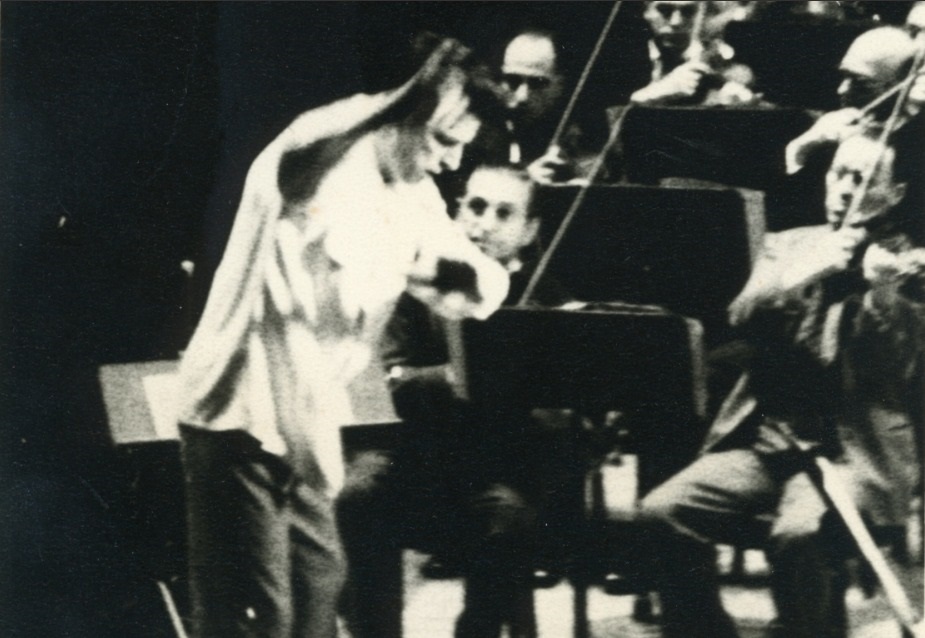
Mussorgsky’s Pictures at an Exhibition is one of the works Cantelli conducted the most. In addition to two concerts (January 22, 1951, February 27, 1952) and an official recording with the NBC SO, two concerts with the Boston SO (February 6 and 7, 1953), and three with the Philharmonia Orchestra (October 21 and 23, 1952 in London and September 11, 1954 in Edinburgh), it is with the New York Philharmonic (NYPO) that we find the greatest number of performances, including twelve in New York (January 24-27, 1952; 25-27 and 29 March 1953; 13, 14, 16 January and 19 March 1955) and eleven on tour between 20 April and 21 May 1955 on the one hand, and between 7 and 25 September 1955 on the other hand.
The present recording reflects the second part of the concert of March 29, 1953, the first part of which (Rossini Il Signor Bruschino Ouv. and Beethoven Concerto No. 1 Op. 15 with Rudolf Serkin) is already available on this blog.
For these ‘Pictures’, Both the interpretation, much more expressive, and the sound recording, are superior to those of the January 27, 1952 concert available in the Music & Arts Boxset CD-1056.
In his review in ‘Musical America’ of this series of end of March 1953 concerts, Ronald Eyer, after having remarked that Cantelli played the Moussorgsky Pictures with a dynamism and a sense of style that made them sound as momentous as masterpieces, attempted the following explanation: ‘This is perhaps the secret of Mr. Cantelli’s genius: he approaches everything as though it were the greatest piece of music ever written’.
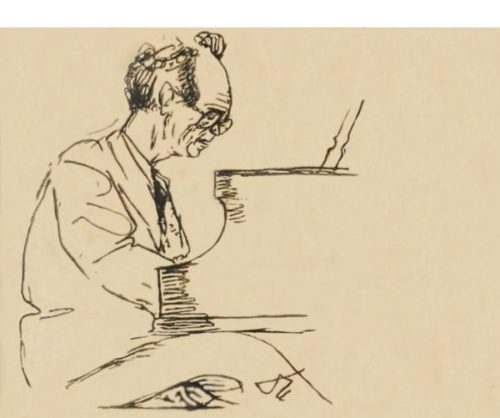
Rudolf Serkin Steinway piano – Guido Cantelli New York Philharmonic (NYPO)
Mozart Concerto n°20 K. 466 (Cadenzas: Beethoven) – Carnegie Hall March 27, 1953
Beethoven Concerto n°1 Op.15 (Cadenza: Beethoven Version III) – Carnegie Hall March 29, 1953
Source: Bande / Tape – 19 cm/s / 7.5 ips
L’invitation de nombreux solistes faisait partie intégrante de la politique des programmes du New York Philharmonic (NYPO). Cantelli a commencé à diriger le NYPO en janvier 1952, et très vite, un nombre appréciable de grands pianistes se sont produits avec lui: successivement de 1952 à 1956, Rudolf Firkušný, Nicole Henriot-Schweitzer, Claudio Arrau, Rudolf Serkin, Robert Casadesus, Walter Gieseking et Wilhelm Backhaus, et une série d’enregistrements radiophoniques nous permet d’apprécier ses qualités exceptionnelles en tant que partenaire, bien plus qu’accompagnateur.
Rudolf Serkin a fêté son cinquantième anniversaire le 28 mars 1953. Avec Guido Cantelli et le NYPO, il a joué les 26 et 27 le Concerto n°20 K.466 de Mozart et le 29, le Concerto n°1 Op.15 de Beethoven. Le jour même de son anniversaire, il a répété le concerto de Beethoven avec l’orchestre.
D’habitude, la Radio ne retransmet que le concert du dimanche dont le programme, comme ici, diffère de ceux qui ont été joués au cours de la semaine. Nous avons cependant la chance d’avoir un enregistrement du concerto de Mozart joué le vendredi 27.
Les critiques musicaux new-yorkais se sont accordés pour trouver mémorable l’interprétation par Serkin du concerto de Mozart et pour louer la direction de Cantelli.
Harris Goldsmith, qui a assisté au concert du 29 alors qu’il était encore étudiant en piano, a relaté bien plus tard à quel point l’interprétation beethovénienne de Serkin, portée par les tempi rapides et fougueux de Cantelli, qui lui rappelaient ceux de Toscanini (avec Ania Dorfmann), était à la fois musicale et intense.
On notera dans le largo du concerto de Beethoven la finesse du dialogue entre le piano et le clarinettiste solo du NYPO, Robert Mc Ginnis.

Inviting a large number of soloists was an integral part of the schedule of the New York Philharmonic (NYPO). Cantelli started conducting the NYPO in January 1952, and very soon, a significant number of great pianists performed with him: successively from 1952 to 1956, Rudolf Firkušný, Nicole Henriot-Schweitzer, Claudio Arrau, Rudolf Serkin, Robert Casadesus, Walter Gieseking and Wilhelm Backhaus, and a series of broadcast recordings allows us to appreciate his exceptional qualities as a partner, rather than an accompanist.
Rudolf Serkin’s fiftieth birthday was on March 28, 1953. With Guido Cantelli and the NYPO, he played Mozart’s Concerto n°20 K.466 on the 26 and 27, and on the 29, Beethoven’s Concerto n°1 Op.15. On the birthday itself, he rehearsed the Beethoven concerto with the orchestra.
Usually, the Radio broadcasts only the Sunday concert whose program, as here, is different from those that have been played during the week. We are however lucky to have a recording of the Mozart’s concerto played on the Friday 27.
New York music critics agreed to find Serkin’s performance of the Mozart concerto memorable and to praise Cantelli’s conducting.
Harris Goldsmith, who attended the concert on the 29 when he was still a piano student, remembered many years later to what extend Serkin’s Beethoven performance, uplifted by Cantelli’s fast and fiery tempi, which reminded him of Toscanini’s (with Ania Dorfmann), was both musical and intense.
Note in the largo of the Beethoven’s concerto the delicacy of the dialog between the piano and the solo clarinettist of the NYPO, Robert Mc Ginnis.

Cadences/Cadenzas: Ferrucio Busoni
Walter Gieseking, Baldwin piano – Guido Cantelli New York Philharmonic (NYPO)
Carnegie Hall – March 6, 1955
Source: Bande / Tape – 19 cm/s / 7.5 ips
Cette interprétation du 6 octobre 1955 documente la rencontre entre Gieseking et Cantelli. C’est le retour de Gieseking avec le NYPO pour la première fois depuis 1939, et c’est une réussite. L’influence réciproque entre les deux interprètes conduit à une interprétation mémorable qui est on ne le peut mieux décrite que par le critique américain Bernard H. Haggin (1900-1987) dans son article de 1968 en hommage à Cantelli:
‘A l’époque, j’ai trouvé que beaucoup d’interprétations de Cantelli étaient merveilleuses; et merveilleux est le mot pour certaines que j’ai entendues récemment, en particulier celle du Concerto pour piano de Mozart K.467. Dans mon expérience, seul Toscanini apportait aux solistes des contextes orchestraux aussi beaux et aussi efficaces que ceux de Cantelli; et dans mon expérience, Toscanini a fourni le précédent pour la chose extraordinaire qui se passe dans l’interprétation par Cantelli du concerto K.467. A un concert du New York Philharmonic en 1934, j’ai entendu Toscanini diriger les concertos K.467 et K.466 avec José Iturbi en soliste, et j’ai entendu Iturbi—sous l’impulsion de la personnalité et du magnétisme du chef—rivaliser avec le jeu puissant de l’orchestre avec un jeu personnel qui était remarquablement différent de son jeu embelli habituel, un style de salon, pour jouer Mozart.
Et la même chose se produit dans l’exécution par Cantelli du concerto K.467. Ce que l’on s’attend à entendre après l’introduction orchestrale superbement exécutée est le style miniature finement ciselé pour jouer Mozart que l’on entend toujours de la part de Gieseking; mais ce que l’on entend à la place, ce sont une énonciation forte et des phrasés forts pour jouer la mélodie, et des doigtés forts pour les séquences de notes rapides et les figurations qui doivent avoir surpris Gieseking comme ils doivent avoir surpris ses auditeurs en 1955 au concert du New York Philharmonic. Jamais auparavant, il n’avait joué Mozart comme cela; et il l’a fait sous la même impulsion de la part de Cantelli que celle que Toscanini avait exercé sur Iturbi. Sous cette impulsion, Iturbi a réussi, et Gieseking réussit, dans l’extraordinaire Andante ce que je n’ai entendu d’aucun autre pianiste au concert: une énonciation et une articulation de la longue cantilène du piano qui soit comparable avec l’enregistrement discographique de Schnabel. Et le jeu de Gieseking dans cette cantilène, contrairement à celui de Schnabel, s’exprime dans le contexte du jeu superbe de la partie orchestrale qui est constamment active—par exemple, les commentaires poignants des bois qui intensifient certaines des énonciations du piano.’

![]()

This October 6, 1955 concert illustrates the meeting between Gieseking and Cantelli. It is Gieseking’s return with the NYPO for the first time since 1939 and it is a success. The reciprocal influence between both musicians leads to a memorable performance best described by US critic Bernard H. Haggin (1900-1987) in his 1968 tribute to Cantelli:
‘Many of Cantelli’s performances I found marvelous at the time; and marvelous is the word for those I have heard recently—in particular the one of Mozart’s Piano Concerto K.467. Only Toscanini, in my experience, provided soloists with orchestral contexts as beautifully made and as effective as Cantelli’s; and Toscanini provided the one precedent in my experience for the astounding thing that happens in Cantelli’s performance of K.467. At a New York Philharmonic concert in 1934, I heard Toscanini perform K.467 and 466 with José Iturbi as soloist, and heard Iturbi—under the compulsion of the personality and magnetism of the man on the podium—match the orchestra’s powerful playing with playing of his own that was strikingly different from his customary prettified salon-style playing of Mozart.
And the same thing happens in Cantelli’s performance of K.467. What one expects to hear after the superbly performed orchestral introduction is the finely chiseled miniature-scale playing of Mozart that one always heard Gieseking do; but what one hears instead is a strongly enunciated, strongly phrased playing of melody, a strong-fingered execution of runs and figuration, that may have amazed Gieseking as it must have amazed his listeners at the New York Philharmonic concert in 1955. He had never played Mozart that way before; and he did so then under the same compulsion from Cantelli as Toscanini had exercised on Iturbi. Under that compulsion, Iturbi achieved, and Gieseking achieves, in the extraordinary Andante what I have heard live from no other pianist: an enunciation and articulation of the piano’s long cantilena comparable with Schnabel’s in his recorded performance. And Gieseking’s playing of this cantilena, unlike Schnabel’s, is heard in the context of the superb playing of the constantly active orchestral part—e.g., the poignant woodwind comments intensifying certain of the piano’s statements.’

Mozart
Symphonie n°38 K.504 WPO Musikvereinsaal 18 Dezember 1936
Symphonie n°41 K.551 WPO Musikvereinsaal 11 Januar (Jänner) 1938
Source: 33t. Angel Japan « The Art of Bruno Walter with WPO »
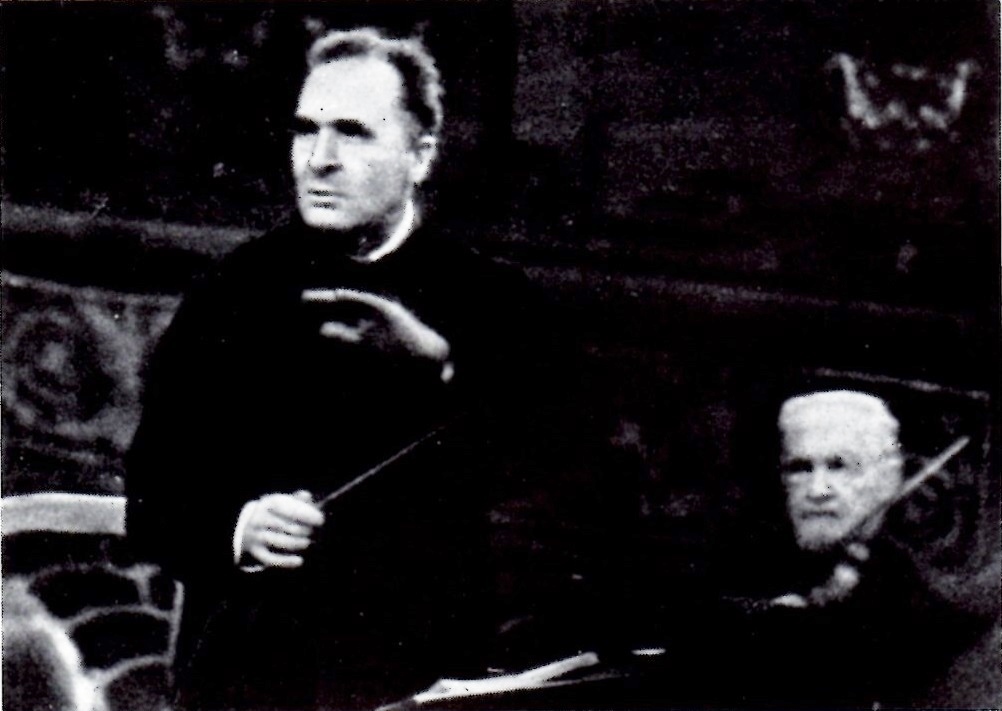
Bruno Walter & Arnold Rosé
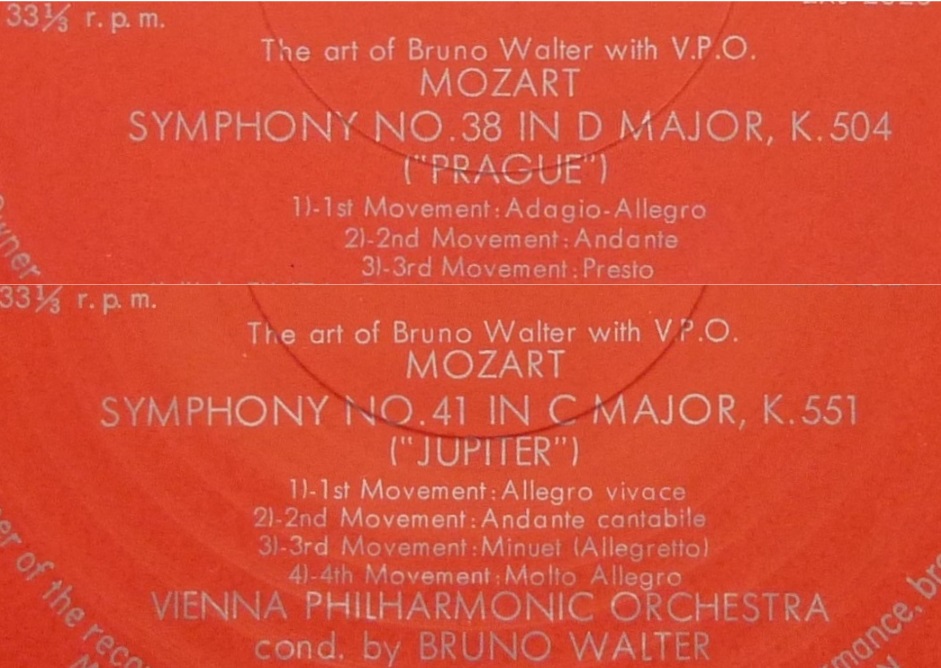
________
Sinfonia Concertante K.364 NYPO John Corigliano & William Lincer Carnegie Hall 10 March 1946 Source: Bande/Tape (origine: disques/transcription discs)
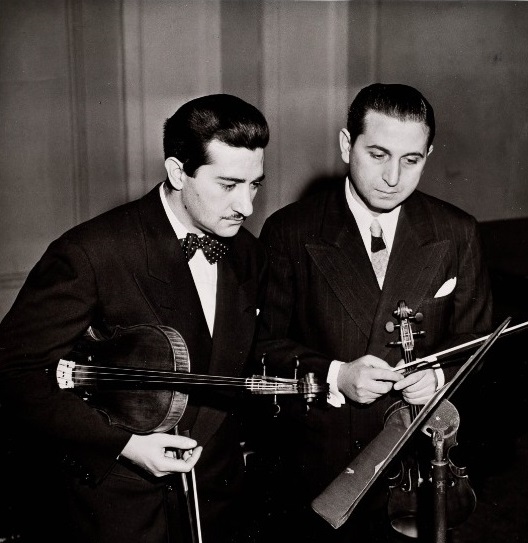
William Lincer & John Corigliano
________
Ces trois enregistrements de Bruno Walter représentent la fin de son activité à Vienne avant la guerre, la Symphonie n°41 accompagnant les 15 et 16 janvier la Neuvième de Mahler au cours de sa dernière série de concerts avant l’Anschluss, ainsi que son unique enregistrement accessible de la Symphonie Concertante pour violon et alto K.364 lors du concert du 10 mars 1946. Il avait déjà dirigé cette œuvre à New York les 5 et 6 mars 1925 avec en solistes Samuel Duskin et Lionel Tertis, et il l’a redonnée les 12 et 13 février 1953 avec Corigliano et Lincer, mais sans retransmission radiophonique à cette occasion. Un enregistrement de concert à Chicago (concert télévisé du 25 janvier 1956 avec John Weicher et Milton Preeves) a été recensé dans une archive privée, mais n’a pas été publié. Le concert du dimanche 10 mars 1946 est particulier en ce sens que son programme (Mozart K364, Brahms Symphonie n°4) est complètement différent de celui des concerts des 7 et 8 mars consacrés à la Passion selon St-Matthieu de Bach, alors qu’en général, le programme radiodiffusé le dimanche reprend en partie le programme de la semaine.
Concernant l’interprétation de la Sinfonia Concertante de Mozart, le critique Noel Straus écrivait: ‘John Corigliano, le concertmaster de l’orchestre, et William Lincer, son premier alto, ont été les solistes de l’opus de Mozart, qui, comme le Brahms, a bénéficié d’une lecture des plus élaborées et des plus élevées. Aucune interprétation ne peut être d’un esprit aussi complètement mozartien que celle qui a été donnée de la Sinfonia Concertante, une oeuvre unique en son genre qui n’a rien perdu de sa fraîcheur juvénile et de son grand attrait au cours des 167 années qui se sont écoulées depuis sa composition. Sous une direction moins, cette composition exquisément façonnée peut facilement dégénérer de la part des deux solistes en une exhibition de virtuosité. Même si une bravoure experte était apportée aux mesures en solo, la musique elle-même et la révélation de sa pleine signification étaient le souci principal de Mr. Walter, et il a montré que c’était possible sans exagérer la composante soliste, avec pour résultat qu’un parfait sens de l’équilibre, rarement obtenu dans cette oeuvre à l’orchestration légère, a été rendu possible. Avec cette manière de faire, la composition a gagné en intimité, et rien n’a été oublié pour projeter le caractère sensible et poétique de son contenu. L’art et la compétence technique de Mr. Corigliano et de Mr. Lincer étaient si complètement en harmonie, leurs sonorités si subtilement intégrées et équilibrées, que leurs jeux formaient remarquablement un tout, et s’inscrivaient en même temps dans le cadre dynamique qui convenait exactement à la fusion avec un accompagnement orchestral finement conçu. Il est difficile d’imaginer un rendu plus éloquent et plus convaincant, ou plus admirable par sa pureté tonale, la beauté de sa texture, par ses couleurs et par son expressivité.’
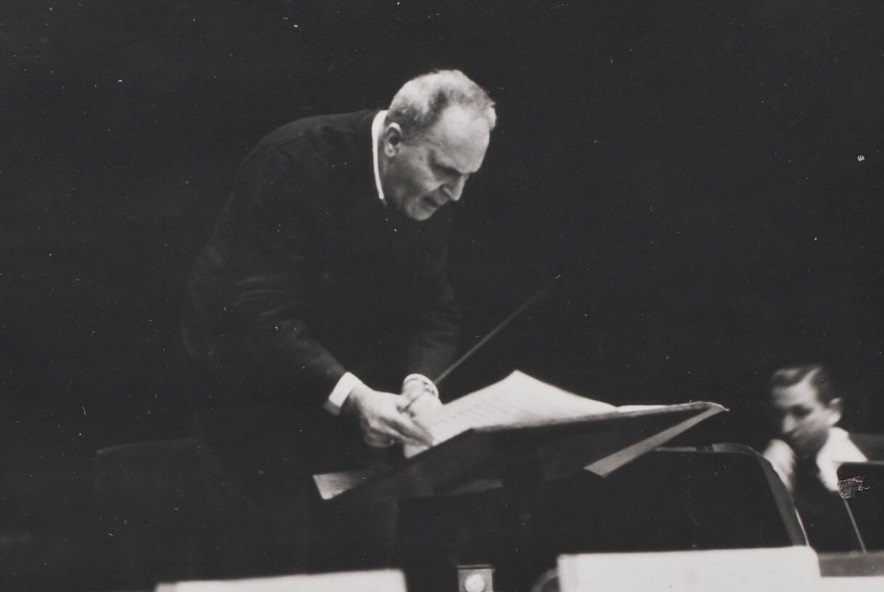


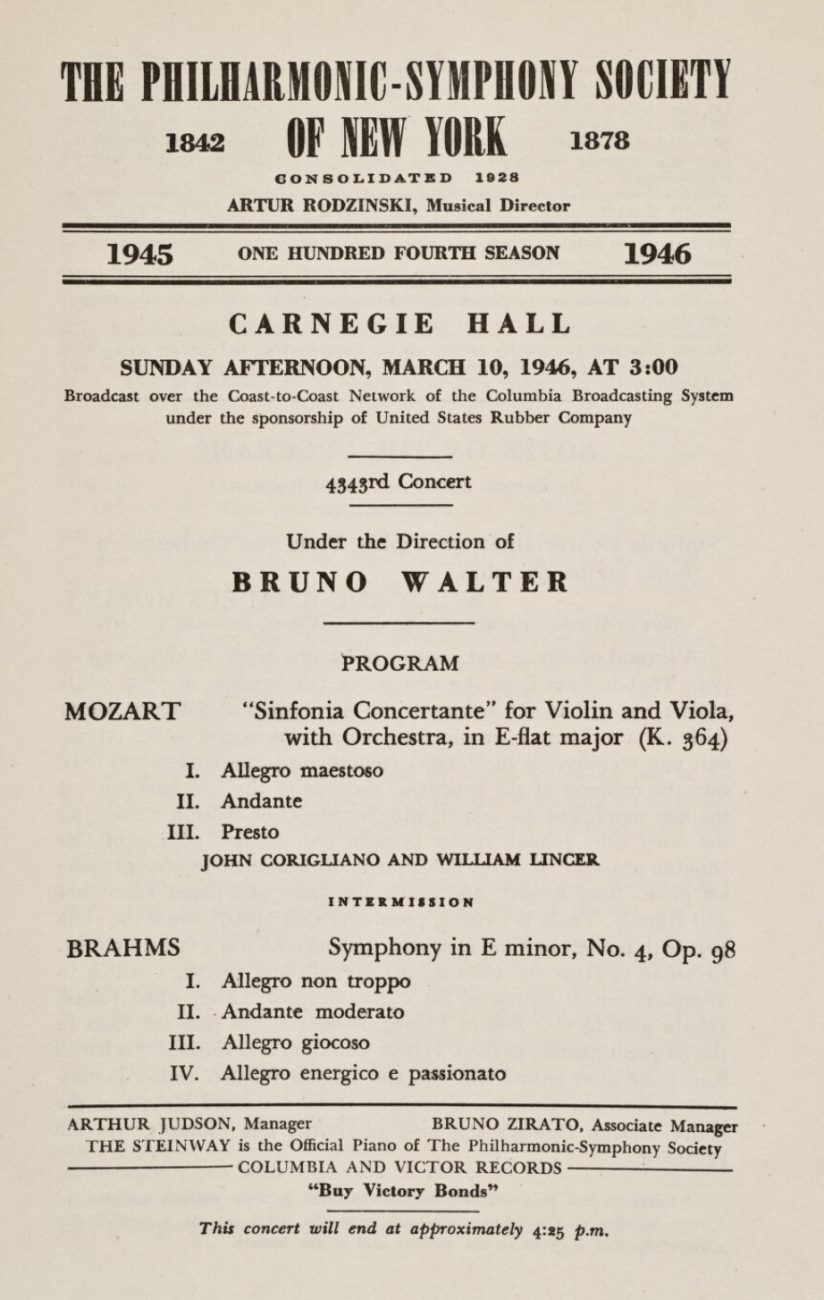
These three Bruno Walter recordings illustrate the end of his pre-war tenure in Vienna, the Symphony n°41 being played on the 15 and 16 January together with the Mahler Ninth during his last series of concerts there before the Anschluss, as well as his only available recording of the Sinfonia Concertante for violin and viola K.364 during the concert of March 10, 1946. He already conducted this work in New York on 5 and 6 March 1925 with Samuel Duskin and Lionel Tertis as soloists, and he performed it again on 12 and 13 February 1953 with Corigliano et Lincer, but without broadcast this time. A concert recording in Chicago (TV concert on 25 January 1956 with John Weicher and Milton Preeves) has been listed in a private archive, but hasn’t been published. The concert of Sunday 10 March 1946 is special in the sense that its program (Mozart K.364, Brahms Symphony n°4) is entirely different from the preceding ones on 7 and 8 March dedicated to Bach’s Passion according to St-Matthew, whereas usually, the program of the Sunday broadcast is partly comprised of works played during the week.
Concerning the performance of the Sinfonia Concertante by Mozart, music critic Noel Straus wrote: ‘John Corigliano, the orchestra’s concertmaster and William Lincer, its first viola, were the soloists in the Mozart opus, which, like the Brahms work, gloried in a reading of a most searching and exalted nature. No performance could be more completely Mozartean in spirit than that given of the Sinfonia Concertante, an unrivaled work of its genre that has lost nothing of its youthful freshness and deep appeal with the passage of the 167 years since its creation. Under less fully comprehending direction, the exquisitely wrought composition easily can become first and foremost an exhibition of virtuosity on the part of the two soloists. But for all the expertness of bravoura brought to the solo measures, the music itself and the revelation of its meaning to the full was the primary consideration with Mr. Walter and this he found possible without overstressing the solo element with the result that a perfect sense of balance, rarely achieved in this lightly orchestrated score, became possible. The composition gained in intimacy through this type of treatment, and nothing was left undone to project the sensitive, poetic character of its content. The artistry and skill of Mr. Corigliano and Mr. Lincer was so perfectly matched, their tone so subtly integrated and equalized, that their playing proved remarkably unified, and at the same time was held in just the right dynamic frame to blend absolutely with the finely considered orchestral support. It is difficult to conceive of a presentation of this work more eloquent and persuasive, or more admirable in tonal purity, beauty of texture, coloring and expressiveness.’
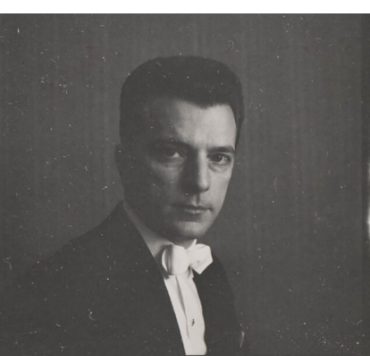
Brahms: Tragische Ouverture Op.81 NBC SO Manhattan Center – January 15, 1951
Brahms: Symphonie n°1 Op.68 NBC SO – Carnegie Hall – December 6, 1952
______
NYPO – Westminster Choir – Carnegie Hall – April 1, 1956
Verdi: Te Deum
Brahms: Alt-Rhapsodie Op.53 NYPO – Martha Lipton
Source: Bande/Tape 19 cm/s / 7.5 ips
Guido Cantelli a peu donné en concert l’Ouverture Tragique de Brahms Op.81, mais par contre sa Première Symphonie Op.68 est l’œuvre qu’il a le plus dirigé. Fin 1950, la NBC a transformé en studio de TV le studio 8-H où avaient lieu la plupart des concerts du NBC SO, et a décidé de les transférer au Manhattan Center, salle à l’acoustique très réverbérée, ce que Toscanini a refusé, seul Carnegie Hall étant pour lui acceptable, et donc seuls d’autres chefs d’orchestre, dont Cantelli, y ont donné temporairement des concerts avec cet orchestre, et la NBC n’a finalement pu que se plier à sa demande.
Le Te Deum de Verdi et la Rhapsodie pour contralto, chœurs d’homme et orchestre Op.53 de Brahms ont été mis au programme des concerts des 29, 30, 31 mars, et 1 avril 1956 du New York Philharmonic et c’est la seule fois qu’il les a dirigées.


Guido Cantelli has seldom performed Brahms’ Tragic Overture Op.81, whereas his first Symphony Op.68 was the work he most conducted. At the end of 1950, the NBC transformed Studio 8-H where most of the NBC SO concerts were given, into a TV studio, and decided to tranfer them to Manhattan Center, a venue with much reverberation, which Toscanini refused, only Carnegie Hall being acceptable to him, and thus only other conductors, among them Cantelli, temporarily gave concerts there with this orchestra and eventually the NBC had to comply with his demand.
Verdi’s Te Deum and Brahms’ Rhapsody for contralto, male chorus and orchestra Op.53 were performed at the New York Philharmonic concerts of March 29, 30, 31 and April 1, 1956 and it it the only time he performed them.



